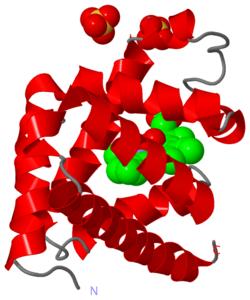JMS/sandbox15
From Proteopedia
(Difference between revisions)
| Line 10: | Line 10: | ||
'''Elephants''' can hold their breath for 2 minutes, but whales can hold their breath for 90 minutes - and they do, migrating underwater around the world. To find out how, a group of researchers contacted museums and zoos around the world<ref name="whaleMyo"> DOI:10.1126/science.1234192</ref>. | '''Elephants''' can hold their breath for 2 minutes, but whales can hold their breath for 90 minutes - and they do, migrating underwater around the world. To find out how, a group of researchers contacted museums and zoos around the world<ref name="whaleMyo"> DOI:10.1126/science.1234192</ref>. | ||
| - | '''They hypothesized that a vital element of whales''' and other aquatic animals' ability to hold their breath for so long is storage of more oxygen in their muscles by increasing the concentration of | + | '''They hypothesized that a vital element of whales''' and other aquatic animals' ability to hold their breath for so long is storage of more oxygen in their muscles by increasing the concentration of myoglobin, the protein that stores oxygen in muscle tissue. |
Specifically, they predicted that species could increase the concentration of myoglobin by increasing its solubility through increasing the number of positively charged regions on the protein's surface, so that even at high concentration the electrostatic repulsion between the myoglobin proteins would prevent their aggregation. | Specifically, they predicted that species could increase the concentration of myoglobin by increasing its solubility through increasing the number of positively charged regions on the protein's surface, so that even at high concentration the electrostatic repulsion between the myoglobin proteins would prevent their aggregation. | ||
| Line 42: | Line 42: | ||
=References:= | =References:= | ||
| - | + | ||
| + | <references /> | ||
Revision as of 21:19, 17 September 2014
| |||||||||||
References:
- ↑ 1.0 1.1 Mirceta S, Signore AV, Burns JM, Cossins AR, Campbell KL, Berenbrink M. Evolution of mammalian diving capacity traced by myoglobin net surface charge. Science. 2013 Jun 14;340(6138):1234192. doi: 10.1126/science.1234192. PMID:23766330 doi:http://dx.doi.org/10.1126/science.1234192
- ↑ Brocchieri L. Environmental signatures in proteome properties. Proc Natl Acad Sci U S A. 2004 Jun 1;101(22):8257-8. Epub 2004 May 24. PMID:15159533 doi:http://dx.doi.org/10.1073/pnas.0402797101
- ↑ Goh CS, Lan N, Douglas SM, Wu B, Echols N, Smith A, Milburn D, Montelione GT, Zhao H, Gerstein M. Mining the structural genomics pipeline: identification of protein properties that affect high-throughput experimental analysis. J Mol Biol. 2004 Feb 6;336(1):115-30. PMID:14741208 doi:http://dx.doi.org/10.1016/S0022283603014748

